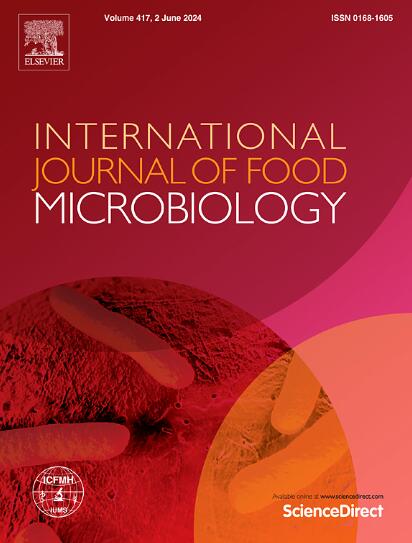流化床干燥微胶囊化酿酒酵母NX2320抑制葡萄灰霉病:细胞膜破坏和氧化应激是关键的抗真菌机制
IF 5
1区 农林科学
Q1 FOOD SCIENCE & TECHNOLOGY
International journal of food microbiology
Pub Date : 2025-06-14
DOI:10.1016/j.ijfoodmicro.2025.111321
引用次数: 0
摘要
葡萄在田间和贮藏期间都极易受到病原真菌感染。利用微生物来抑制病原体和保存水果和蔬菜已经获得了重要的研究关注。然而,由于运输和保存方面的挑战,以及它们的生存时间短,自由微生物的应用受到限制,这限制了它们在食品工业中的实际应用。在本研究中,酿酒酵母NX2320在马铃薯葡萄糖琼脂(PDA)培养基中表现出对灰葡萄孢的有效抑制作用。为提高酿酒酵母NX2320的稳定性和抑菌效果,采用海藻酸钠和壳聚糖联合真空冷冻干燥(VFD)和山梨糖醇单硬脂酸酐联合流化床干燥(FBD)两种不同的方法对其进行微胶囊化。对比分析表明,FBD法制备的酿酒酵母NX2320微胶囊比VFD法制备的NX2320微胶囊具有更好的抗真菌活性和稳定性。FBD微胶囊已成功应用于葡萄的田间和贮藏过程中。与未处理的对照相比,酿酒葡萄NX2320微胶囊处理显著降低了葡萄的病害指数和腐烂率,同时提高了葡萄的整体品质。转录组分析和生化验证表明,酿酒酵母NX2320微胶囊对灰葡萄球菌的主要抑菌机制为细胞膜破坏和氧化应激。此外,挥发性有机化合物(VOCs)是微胶囊产生的关键抗真菌物质。这些发现突出了酿酒酵母NX2320微胶囊作为葡萄田间和贮藏条件下有效的生物防治剂的潜力。本文章由计算机程序翻译,如有差异,请以英文原文为准。
Microencapsulated Saccharomyces cerevisiae NX2320 via fluidized bed drying suppresses Botrytis cinerea in grapes: Cell membrane disruption and oxidative stress as key antifungal mechanisms
Grapes are highly susceptible to pathogenic fungal infections both in the field and during storage. The use of microorganisms to inhibit pathogens and preserve fruits and vegetables has garnered significant research attention. However, the application of free microorganisms is limited due to challenges in transportation and preservation, as well as their short survival time, which restricts their practical use in the food industry. In this study, Saccharomyces cerevisiae NX2320 demonstrated effective inhibition of Botrytis cinerea growth in Potato Dextrose Agar (PDA) media. To enhance its stability and antifungal efficacy, S. cerevisiae NX2320 was microencapsulated using two distinct methods: (1) sodium alginate and chitosan combined with vacuum freeze-drying (VFD), and (2) sorbitol anhydride monostearate with fluidized bed drying (FBD). Comparative analysis revealed that S. cerevisiae NX2320 microcapsules prepared via FBD exhibited superior antifungal activity and stability compared to those produced using VFD. The FBD microcapsules were successfully applied to grapes both in the field and during storage. Treatment with S. cerevisiae NX2320 microcapsules significantly reduced the disease index and decay percentage while improving the overall quality of the grapes compared to untreated controls. Transcriptome analysis and biochemical validation identified cell membrane disruption and oxidative stress as the primary antifungal mechanisms of S. cerevisiae NX2320 microcapsules against B. cinerea. Additionally, volatile organic compounds (VOCs) were identified as the key antifungal substances produced by the microcapsules. These findings highlight the potential of S. cerevisiae NX2320 microcapsules as an effective biocontrol agent for grape preservation in both field and storage conditions.
求助全文
通过发布文献求助,成功后即可免费获取论文全文。
去求助
来源期刊
CiteScore
10.40
自引率
5.60%
发文量
322
审稿时长
65 days
期刊介绍:
The International Journal of Food Microbiology publishes papers dealing with all aspects of food microbiology. Articles must present information that is novel, has high impact and interest, and is of high scientific quality. They should provide scientific or technological advancement in the specific field of interest of the journal and enhance its strong international reputation. Preliminary or confirmatory results as well as contributions not strictly related to food microbiology will not be considered for publication.

 求助内容:
求助内容: 应助结果提醒方式:
应助结果提醒方式:


